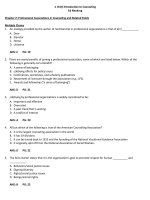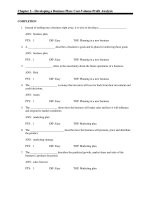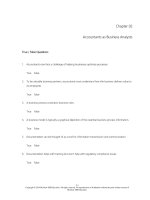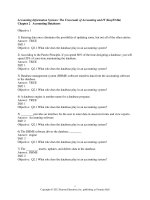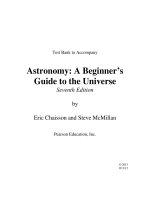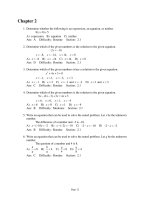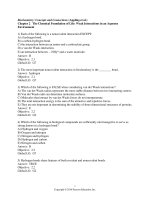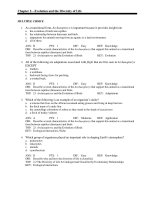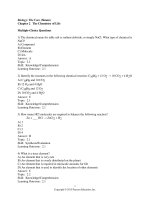Biology the core 1st edition simon test bank
Bạn đang xem bản rút gọn của tài liệu. Xem và tải ngay bản đầy đủ của tài liệu tại đây (191.15 KB, 16 trang )
Biology: The Core (Simon)
Chapter 2 The Chemistry of Life
Multiple-Choice Questions
1) The chemical name for table salt is sodium chloride, or simply NaCl. What type of chemical is
NaCl?
A) Compound
B) Element
C) Molecule
D) Ion
Answer: A
Topic: 2.1
Skill: Knowledge/Comprehension
Learning Outcome: 2.1
2) Identify the reactants in the following chemical reaction: C10H8 + 12 O2 → 10 CO2 + 4 H2O
A) C10H8 and 10 CO2
B) 12 O2 and 4 H2O
C) C10H8 and 12 O2
D) 10 CO2 and 4 H2O
Answer: C
Topic: 2.1
Skill: Knowledge/Comprehension
Learning Outcome: 2.1
3) How many HCl molecules are required to balance the following reaction?
Zn + ___ HCl → ZnCl2 + H2
A) 1
B) 2
C) 3
D) 4
Answer: B
Topic: 2.1
Skill: Synthesis/Evaluation
Learning Outcome: 2.1
4) What is a trace element?
A) An element that is very rare
B) An element that is evenly distributed on the planet
C) An element that is required in miniscule amounts for life
D) An element that is used to identify the location of other elements
Answer: C
Topic: 2.2
Skill: Knowledge/Comprehension
Learning Outcome: 2.1
1
Copyright © 2015 Pearson Education, Inc.
5) What is the most common element in your body?
A) Oxygen
B) Water
C) Carbon
D) Sugar
Answer: A
Topic: 2.2
Skill: Knowledge/Comprehension
Learning Outcome: 2.1
6) Which is not one of the four atoms that make up the bulk of living organisms?
A) Oxygen
B) Nitrogen
C) Calcium
D) Carbon
Answer: C
Topic: 2.2
Skill: Knowledge/Comprehension
Learning Outcome: 2.1
7) The majority of the elements essential to life are found in what part of the periodic table?
A) The top third
B) The middle third
C) The bottom third
D) Evenly distributed throughout the periodic table
Answer: A
Topic: 2.2
Skill: Application/Analysis
Learning Outcome: 2.1
2
Copyright © 2015 Pearson Education, Inc.
8) The typical carbon atom is described in the periodic table by the accompanying box. How
many protons are in a typical carbon atom?
A) 6
B) 12
C) 18
D) Not enough information given
Answer: A
Topic: 2.2
Skill: Knowledge/Comprehension
Learning Outcome: 2.1
9) How many neutrons are in a typical carbon atom?
A) 6
B) 12
C) 18
D) Not enough information given
Answer: A
Topic: 2.2
Skill: Knowledge/Comprehension
Learning Outcome: 2.1
Global Learning: G4
3
Copyright © 2015 Pearson Education, Inc.
10) Which number represents the atomic weight of carbon?
A) 6
B) 12
C) 18
D) Not enough information given
Answer: B
Topic: 2.2
Skill: Knowledge/Comprehension
Learning Outcome: 2.1
11) How many neutrons in a carbon-14 atom?
A) 6
B) 7
C) 8
D) 14
Answer: C
Topic: 2.3
Skill: Application/Analysis
Learning Outcome: 2.1
Global Learning: G4
12) If the number of protons in an atom does not match the number of electrons, the atom is
specifically called an ________.
A) element
B) isotope
C) isomer
D) ion
Answer: D
Topic: 2.3
Skill: Application/Analysis
Learning Outcome: 2.1
4
Copyright © 2015 Pearson Education, Inc.
13) The 2+ in Cu2+ tells us that this atom ________.
A) has two more neutrons than protons
B) has two more protons than electrons
C) has two more electrons than neutrons
D) has two more electrons than protons
Answer: B
Topic: 2.3
Skill: Application/Analysis
Learning Outcome: 2.1
14) Identify the part of the atom that most determines the chemical reactivity of the atom.
A) The number of shells
B) The number of protons
C) The number of neutrons
D) The number of electrons
Answer: D
Topic: 2.3
Skill: Knowledge/Comprehension
Learning Outcome: 2.2
15) In chemical bonding, when the bonded atoms share electrons, it is specifically called
________.
A) an ionic bond
B) a covalent bond
C) a hydrogen bond
D) a polar bond
Answer: B
Topic: 2.4
Skill: Knowledge/Comprehension
Learning Outcome: 2.2
16) What is the maximum number of electrons that can fit into the innermost shell of an atom?
A) 1
B) 2
C) 8
D) 16
Answer: B
Topic: 2.4
Skill: Knowledge/Comprehension
Learning Outcome: 2.2
5
Copyright © 2015 Pearson Education, Inc.
17) While the maximum number of electrons required to fill the outermost shell of an atom
varies depending on the size of the atom, almost all of the smaller atoms (atomic numbers 2-20)
are considered stable (nonreactive) when they contain ________ electron(s) in the outermost
shell.
A) 1
B) 2
C) 8
D) 16
Answer: C
Topic: 2.4
Skill: Synthesis/Evaluation
Learning Outcome: 2.2
18) What is the maximum number of single covalent bonds a carbon atom can form with other
elements?
A) 1
B) 2
C) 3
D) 4
Answer: D
Topic: 2.4
Skill: Application/Analysis
Learning Outcome: 2.2
Global Learning: G4
19) Individual water molecules are held to one another by relatively weak ________ bonds.
A) covalent
B) hydrogen
C) ionic
D) nonpolar
Answer: B
Topic: 2.4
Skill: Knowledge/Comprehension
Learning Outcome: 2.2
6
Copyright © 2015 Pearson Education, Inc.
20) The electronegativity of an atom is determined by how strongly outermost electrons are
pulled toward the nucleus. Somewhat like gravity, the electronegativity will be stronger in atoms
with larger nuclei and closer outermost electrons. Which element has the strongest
electronegativity?
A) Boron
B) Carbon
C) Nitrogen
D) Oxygen
Answer: D
Topic: 2.4
Skill: Synthesis/Evaluation
Learning Outcome: 2.2
21) Why is one side of a water molecule partially negative while the other side is partially
positive?
A) Uneven sharing of electron pairs occurs due to the strong pull of hydrogen.
B) Uneven sharing of electron pairs occurs due to the strong pull of oxygen.
C) Oxygen donates its electrons to hydrogen.
D) Hydrogen donates its electrons to oxygen.
Answer: B
Topic: 2.4
Skill: Application/Analysis
Learning Outcome: 2.2
22) Water is the lightest (least dense) when it ________.
A) freezes
B) is just above freezing
C) is at room temperature
D) is just below boiling
Answer: A
Topic: 2.5
Skill: Knowledge/Comprehension
Learning Outcome: 2.3
7
Copyright © 2015 Pearson Education, Inc.
23) A needle can be made to "float" on the surface tension of water. What causes this surface
tension to form?
A) The adhesion of water molecules to the needle
B) The cohesion of water molecules to each other
C) The solubility of water
D) The heat capacity of water
Answer: B
Topic: 2.5
Skill: Application/Analysis
Learning Outcome: 2.3
Global Learning: G5
24) Water "beads up" on synthetic fabric like polyester but binds to cotton. What is the most
likely explanation for this?
A) Polyester is not a naturally occurring substance, whereas cotton is a naturally occurring
substance.
B) Polyester is more flexible than cotton.
C) Polyester fibers are thinner than cotton fibers.
D) Polyester is nonpolar, whereas cotton is polar.
Answer: D
Topic: 2.5
Skill: Application/Analysis
Learning Outcome: 2.3
Global Learning: G5
25) Select the most complete explanation of what the pH scale actually measures.
A) The acidity of a solvent
B) The alkalinity of a solvent
C) The concentration of hydrogen ions in a solution
D) The concentration of hydroxide ions in a solute
Answer: C
Topic: 2.6
Skill: Knowledge/Comprehension
Learning Outcome: 2.3
26) The difference in pH units between two acidic solutions is three. How much more acidic is
the stronger acid than the weaker acid?
A) 3 times more acidic
B) 30 times more acidic
C) 100 times more acidic
D) 1,000 times more acidic
Answer: D
Topic: 2.6
Skill: Application/Analysis
Learning Outcome: 2.3
Global Learning: G4
8
Copyright © 2015 Pearson Education, Inc.
27) Something with a pH of 5 would be ________.
A) acidic
B) basic
C) neutral
D) alkaline
Answer: A
Topic: 2.6
Skill: Knowledge/Comprehension
Learning Outcome: 2.3
28) How do buffers minimize change in the pH of biological systems?
A) By absorbing H+ ions when there is an excess
B) By donating H+ ions when there is a shortage
C) Both of these
D) Neither of these
Answer: C
Topic: 2.6
Skill: Knowledge/Comprehension
Learning Outcome: 2.3
29) The functional group -NH2 is called the ________ group.
A) methyl
B) alcohol
C) amino
D) carboxyl
Answer: C
Topic: 2.7
Skill: Knowledge/Comprehension
Learning Outcome: 2.4
30) If you remove all of the functional groups from an organic molecule such that it contains
only carbon and hydrogen atoms, the molecule is called ________.
A) a carbohydrate
B) an inorganic molecule
C) a hydrocarbon
D) polar
Answer: C
Topic: 2.7
Skill: Application/Analysis
Learning Outcome: 2.4
9
Copyright © 2015 Pearson Education, Inc.
31) Which of the following large organic molecules includes table sugar?
A) Carbohydrates
B) Lipids
C) Proteins
D) Nucleic acids
Answer: A
Topic: 2.7, 2.9
Skill: Knowledge/Comprehension
Learning Outcome: 2.4
32) The breaking of a large organic molecule into smaller individual subunits involves multiple
________.
A) hydrolysis reactions
B) osmotic reactions
C) dehydration synthesis reactions
D) hydrosynthetic reactions
Answer: A
Topic: 2.8
Skill: Knowledge/Comprehension
Learning Outcome: 2.5
33) What are the monomers of proteins?
A) Hydrochloric acids
B) Nucleic acids
C) Carboxylic acids
D) Amino acids
Answer: D
Topic: 2.8, 2.12
Skill: Knowledge/Comprehension
Learning Outcome: 2.6
34) What is the sum total of all the chemical reactions that take place in your body called?
A) Catabolism
B) Anabolism
C) Embolism
D) Metabolism
Answer: D
Topic: 2.8
Skill: Knowledge/Comprehension
Learning Outcome: 2.5
10
Copyright © 2015 Pearson Education, Inc.
35) What is another name for the polymers of carbohydrates?
A) Triglycerides
B) Polysaccharides
C) Polypeptides
D) Nucleotides
Answer: B
Topic: 2.9
Skill: Knowledge/Comprehension
Learning Outcome: 2.6
36) Which of the following is not made from long chains of glucose?
A) Starch
B) Glycerol
C) Glycogen
D) Cellulose
Answer: B
Topic: 2.9
Skill: Knowledge/Comprehension
Learning Outcome: 2.6
37) Based on the suffix, a molecule of "maltose" is most likely what type of macromolecule?
A) Carbohydrate
B) Lipid
C) Protein
D) Nucleic acid
Answer: A
Topic: 2.9
Skill: Application/Analysis
Learning Outcome: 2.6
Global Learning: G2
38) Which polysaccharide consists of many long straight chains of glucose with bonds joining
the chains?
A) Starch
B) Cellulose
C) Glycogen
D) This does not describe a polysaccharide.
Answer: B
Topic: 2.9
Skill: Knowledge/Comprehension
Learning Outcome: 2.6
11
Copyright © 2015 Pearson Education, Inc.
39) Which polysaccharide consists of individual long, twisted, unbranched chains of glucose?
A) Starch
B) Cellulose
C) Glycogen
D) This does not describe a polysaccharide.
Answer: A
Topic: 2.9
Skill: Knowledge/Comprehension
Learning Outcome: 2.6
40) Lipids are all ________.
A) hydrophonic
B) hydrophilic
C) hydrophobic
D) hydrolytic
Answer: C
Topic: 2.10
Skill: Knowledge/Comprehension
Learning Outcome: 2.6
41) Which combination describes the plasma membrane?
A) Hydrophilic interior, hydrophobic exterior
B) Hydrophilic interior and exterior
C) Hydrophobic interior, hydrophilic exterior
D) Hydrophobic interior and exterior
Answer: C
Topic: 2.10
Skill: Knowledge/Comprehension
Learning Outcome: 2.6
42) What is the basic structure of most lipids?
A) A glycerol head and up to three fatty acid tails
B) A linear chain of individual monomers
C) A branched chain of individual monomers
D) A ring with carbon, hydrogen, and oxygen in a 1:2:1 ratio
Answer: A
Topic: 2.10
Skill: Knowledge/Comprehension
Learning Outcome: 2.6
12
Copyright © 2015 Pearson Education, Inc.
43) Which of the following dietary fats is considered to be the most healthy?
A) Saturated fat
B) Unsaturated fat
C) Trans fat
D) Cholesterol
Answer: B
Topic: 2.11
Skill: Knowledge/Comprehension
Learning Outcome: 2.6
Global Learning: G5
44) Oil hydrogenation can produce a product, such as vegetable shortening or margarine, that is
spreadable at room temperature. What is the name of this category of lipid?
A) Saturated fat
B) Unsaturated fat
C) Trans fat
D) Cholesterol
Answer: C
Topic: 2.11
Skill: Knowledge/Comprehension
Learning Outcome: 2.6
Global Learning: G5
45) Which would have the highest concentration of C-H bonds?
A) Saturated fat
B) Unsaturated fat
C) Trans fat
D) Cholesterol
Answer: A
Topic: 2.11
Skill: Application/Analysis
Learning Outcome: 2.6
46) What gives an amino acid its unique chemical properties?
A) The different amino groups
B) The sequence of amino acids in a chain
C) The bond that forms between amino acids
D) The side group
Answer: D
Topic: 2.12
Skill: Knowledge/Comprehension
Learning Outcome: 2.6
13
Copyright © 2015 Pearson Education, Inc.
47) To a large extent, a protein's function is dependent upon its shape. What determines a
protein's shape?
A) The location of the active site
B) The sequence of amino acids
C) The concentration of carbon-to-hydrogen single bonds
D) The number of carbon-to-carbon double bonds
Answer: B
Topic: 2.12
Skill: Application/Analysis
Learning Outcome: 2.6
48) Proteins are diverse molecules that perform a wide variety of functions. Which of the
following is not a typical function of proteins?
A) Defense
B) Catalyze reactions
C) Movement
D) Energy storage
Answer: D
Topic: 2.12
Skill: Knowledge/Comprehension
Learning Outcome: 2.6
49) What might lead to a protein that does not function properly?
A) Incorrect folding of the amino acid chain
B) The active site becoming blocked
C) The active site becoming distorted
D) All of these
Answer: D
Topic: 2.12, 2.13
Skill: Application/Analysis
Learning Outcome: 2.6
50) Organic molecules that end in the suffix "-ase" often function as ________ molecules.
A) structural
B) enzymatic
C) transport
D) storage
Answer: B
Topic: 2.13
Skill: Application/Analysis
Learning Outcome: 2.6
14
Copyright © 2015 Pearson Education, Inc.
51) Identify the substrate in the following reaction: Sucrose → Fructose + Glucose
A) Sucrose
B) Fructose
C) Glucose
D) Fructose and glucose
Answer: A
Topic: 2.13
Skill: Application/Analysis
Learning Outcome: 2.1
52) What will be accomplished by lowering the activation energy of a reaction?
A) The reaction will proceed more slowly.
B) The reaction will proceed more quickly.
C) The reaction will stop completely.
D) The reaction will reverse.
Answer: B
Topic: 2.13
Skill: Application/Analysis
Learning Outcome: 2.6
Global Learning: G2
Short-Answer Questions
53) An old home remedy for anemia was to drink from a jug of water into which was added a
handful of iron nails. Why might this have been effective at treating certain forms of anemia?
Answer: Possible Answer: Iron is an essential nutrient and the water would have contained iron.
If the anemia was the result of an iron deficiency, drinking from the nail water could have added
the essential element to the diet.
Topic: 2.2
Skill: Synthesis/Evaluation
Learning Outcome: 2.1
Global Learning: G2, G5
54) Which of the three gasses is the easiest to break apart, nitrogen gas (N2), oxygen gas (O2), or
hydrogen gas (H2)? Which is the most difficult to break apart? What accounts for the
differences?
Answer: Possible Answer: Hydrogen gas, with a single covalent bond, is the easiest to break
apart. Nitrogen gas, with a triple covalent bond, is the most difficult. Oxygen gas has a double
covalent bond which is intermediate in strength to the weaker single and stronger triple.
Topic: 2.4
Skill: Application/Analysis
Learning Outcome: 2.2
Global Learning: G2
15
Copyright © 2015 Pearson Education, Inc.
55) Why does sweating cool your skin on a hot, dry day but makes you feel warmer on a hot,
humid day?
Answer: Possible Answer: The evaporative cooling of sweat cools the skin as the water and the
heat it has absorbed move from the skin to the drier air. Sweat does not evaporate as well on a
humid day, tending instead to build up on the skin, insulating the body rather than cooling it.
Topic: 2.5
Skill: Synthesis/Evaluation
Learning Outcome: 2.3
Global Learning: G2
56) Individual amino acids have unique chemical qualities but these do not directly determine the
function of an enzyme. What then is the role of the individual amino acid's unique chemical
qualities and what then directly determines the function of an enzyme?
Answer: Possible Answer: The side groups of an amino acid are what give the amino acid its
unique chemical qualities. These allow specific amino acids in the polypeptide chain to bind to
other specific amino acids, which fold and twist the polypeptide into a specific three-dimensional
shape. The shape may include an indentation called the active site that directly functions as the
binding site for the substrate. Active sites often include cofactors and coenzymes that improve its
functionality. They will not function without these factors even if the amino acid sequence and
folding pattern are correct.
Topic: 2.12, 2.13
Skill: Synthesis/Evaluation
Learning Outcome: 2.6
Global Learning: G2
57) Penicillin is a competitive inhibitor produced by a fungus in order to kill invading bacteria. It
does this by mimicking the substrate required by the bacterium to build and repair its cell wall.
Describe how mimicking the substrate would result in the death of the bacterium.
Answer: Possible Answer: As a competitive inhibitor, it must bind to the active site of the
bacterial enzyme where the correct substrate typically binds. Binding to the active site blocks the
correct substrate from binding and prevents the correct products from being formed. Without
these products, the bacterium cannot repair its cell wall and will die.
Topic: 2.13
Skill: Synthesis/Evaluation
Learning Outcome: 2.6
Global Learning: G5
16
Copyright © 2015 Pearson Education, Inc.
